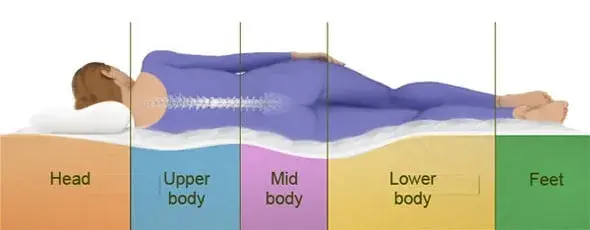The only time when a body's bones, muscles, ligaments and other structures of the spine are in a completely relaxed mode is during sleep time. In cases of a spinal disorder or back injury, it becomes even more important to sleep well in order to aid the healing process.
However, a 'good night's rest' is often overlooked by many, and individuals wake up feeling tired, instead of refreshed and relaxed. A 2011 research by the British Chiropractic Association on people experiencing back pain showed that 41% of women and 36% of the men blamed their pain on the night's rest.
Along with adequate hours of rest, a supporting bed mattress and a cushion are important accessories for a proper rest to the spine.
Let's take a detailed look at how mattresses and pillows help the spine:
[caption align="aligncenter" width="585"] Source: Choose Mattresses[/caption]
Source: Choose Mattresses[/caption]
Mattresses for Spine and Back
The best mattress is one that supports the back in a sleeping position.
The right mattress for an individual will depend on his/her predominant sleeping position. For example, for those who prefer lying on the side, the spine should be parallel to the mattress. Thus, if the mattress is too soft, the spine will sag, and if the mattress is too hard, the spine will form a bow.
The mattress contains various components that assist an individual in getting a good night's sleep. The springing, foams, stuffing and the cover are parts of a mattress aimed at providing comfort to the spine.
Knowing when to part with an old mattress
Mattresses change with time and use, as also do bodies.
An old mattress that was comfortable years ago might not provide that same sound sleep today. In addition, mattresses collect dust mites, germs and fungus that can impact sleep patterns or exaggerate allergic conditions.
A general life span of a mattress is ten years. Important indicators of a mattress' condition are the base of the springs or distortion or central ridge formed at places where the body weight has been the most.
Avoiding cervical pain with pillows
While in sleeping position, the neck should be in the same straight line as the spine, neither too high nor too low.
The right pillow can make a difference in the sleeping position, and affect how relaxed the neck feels the next day. This is particularly important for individuals suffering from a neck sprain or strain (whiplash injury).
Traditional pillows merely raise the head, leaving the neck unsupported and sagging. Cervical pillows are ergonomically designed cushions that provide support for the neck during sleep by cradling the head, neck and shoulders. A cervical pillow holds the neck and head at right angles when a person is in a resting position. A cervical pillow rises in the area of the neck and compresses in the area where the headrests. This allows for the variation in angle and spacing that is created between the body and the mattress. The material within the pillow (generally memory foam) accommodates the compressing and decompressing required for contouring the neck for providing optimal support and ergonomical comfort.
Also, read about: Healing Acupressure Points for Back PainSelecting cervical pillows
A pillow must be selected on the basis of how well it fits an individual, the sleeping position and the mattress.
The pillow must fill the space between the mattress and the ear. Proper support to the head and neck allows for optimal spine alignment. Following steps help select and use a cervical pillow optimally:
- Fitting pillow to sleep position - Those who sleep on the back require flatter, thinner neck support. Those who sleep on the side require a thicker pillow, and those who sleep on their stomach can place a thin head pillow under their chest, or no pillow at all. For example, for those sleeping on the side, the pillow must support the head in line with the neck, and should not tilt up or down.
- Fitting pillow to mattress - A firm mattress requires a thicker pillow, while a soft mattress requires a thinner pillow.
- Fitting pillow to body - The curves of a pillow must match the natural curves of the upper back and neck.
Individuals can also create more neck support from pillows that may be of the right height but do not offer enough neck support by transforming a normal pillow into a 'cervical roll'. Inserting a soft supportive roll inside the pillowcase at the lower edge of the pillow converts a regular pillow into an orthopaedic support pillow.
Related read : Best Sleeping Position For Your Back Pain For more information or free personalized guidance, feel free to speak to Credihealth expert at +918010994994.
Reviewed by







